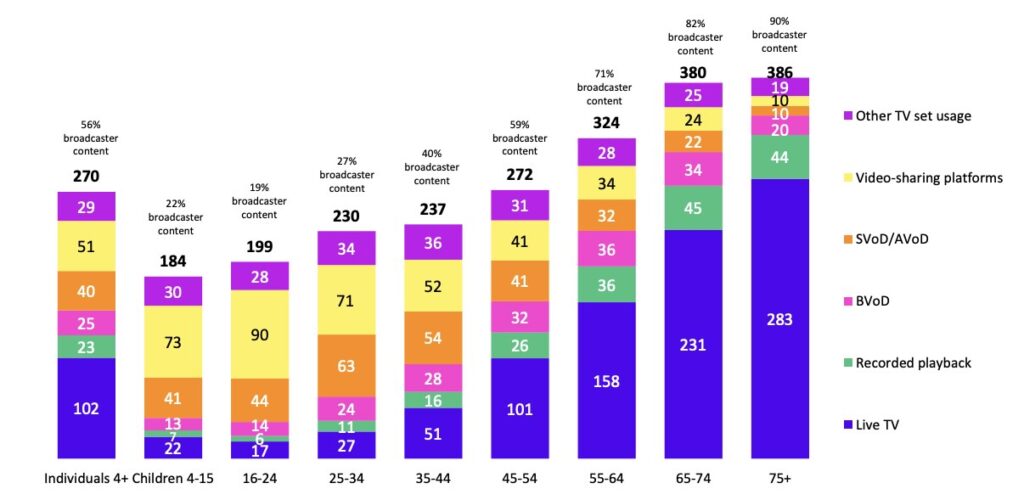Key Takeaways from Ofcom’s Media Nations Report 2025
Insights
08.05.25
By: Stuart Bryan

The Ofcom Media Nations report 2025 has landed. As always, it’s packed full of juicy insights for brands, agencies, and just about anyone with a passing interest in how Brits are engaging with media.
We appreciate you’re busy, so, being the lovely folk we are, we’ve distilled the key takeaways down into this blog post. Read on for the big talking points.
Broadcast TV still accounts for the lion’s share of viewing, despite decline
Individuals aged 4+ consumed 4 hours 30 minutes of video content per day in 2024 – one minute less than in 2023. Of that, 2 hours 24 minutes per day were attributable to broadcast TV – representing a year-on-year decline of 4%. 84% of in-home video viewing was through the TV set.
There’s no shying away from the fact that the ways we’re watching video content are changing. Young adults (16-24) continue to move away from live television, with YouTube and Subscription Video-on-Demand (SVoD) now the first port of calls.
However, as the graph below illustrates, live TV viewing remains dominant among adults aged 55+ in terms of average daily video minutes, confirming the growing disparity in viewing habits between age groups.
Ultimately, the Media Nations report underlines what has been known for a while: effective AV planning now requires a multifaceted approach; plans should encompass a mix of live TV, BVoD, SVoD and, in the case of younger viewers, online platforms such as YouTube to ensure healthy reach and frequency metrics. The exact nature of spend allocations will depend on the audience – there is no one-size-fits-all approach.
Online video ripe with opportunity for broadcasters
Broadcasters aren’t sitting on their thumbs when it comes to online video. Aware that YouTube is now a primary source of content for younger viewers in particular, the likes of ITV and Channel 4 are striking agreements with the platform to air selected programming – with control of ad inventory maintained.
This is a development worth keeping an eye on. The lingering concerns around quality control on YouTube are negated by the provision of premium broadcaster content, while new opportunities to reach typically light TV viewers are to be welcomed.
Reflecting this growing convergence between TV and online, Enders Analysis found that half of YouTube’s most viewed content now resembles traditional TV. Clearly, there is an appetite for long-form video content, so expect broadcasters to continue gravitating towards the platform.
Live radio remains stable despite wealth of listening options
RAJAR research has revealed that almost nine in ten UK adults aged 15 and over listened to live radio for an average of 20.5 hours per week in Q1 2025.
This reach is impressive when considering the popularity of streaming platforms. Indeed, it suggests that live radio remains a valued part of a person’s daily routine – be it pottering at home or driving to and from work.
Such resilience is largely down to DAB, the report suggests, with 42% of all listening attributable to digital stations; this is followed by AM/FM services at 27%. DAB’s popularity is being fuelled in part by the increasing prevalence of live radio consumption on home smart speakers; listening hours rose by 18% on such devices in 2024.
The surge in targeted radio stations is also a factor, with Global launching a raft of extensions to Heart, Capital, Smooth, Radio X and Classic FM centred on particular decades and genres in 2024. These tailored offerings are not only good news for listeners: they’re great news for advertisers looking to engage particular audiences.
To find out more about wider trends in the UK media landscape, or to get the ball rolling on your own campaign, contact our experts for a chat today.

Insights
05.08.25
Key Takeaways from Ofcom’s Media Nations Report 2025
Ofcom’s Media Nations Report 2025 has landed. As always, it's packed full of juicy insights for brands and agencies. Read on fo...

News
01.08.25
Scam alert
We’ve been alerted to scammers impersonating Guerillascope via text and email. Please continue reading for further information.

Insights
29.05.25
Why an always-on strategy is always a wise move
Let’s get right to it: implementing an always-on strategy broadens a brand’s capacity to reach potential customers at key touch...
